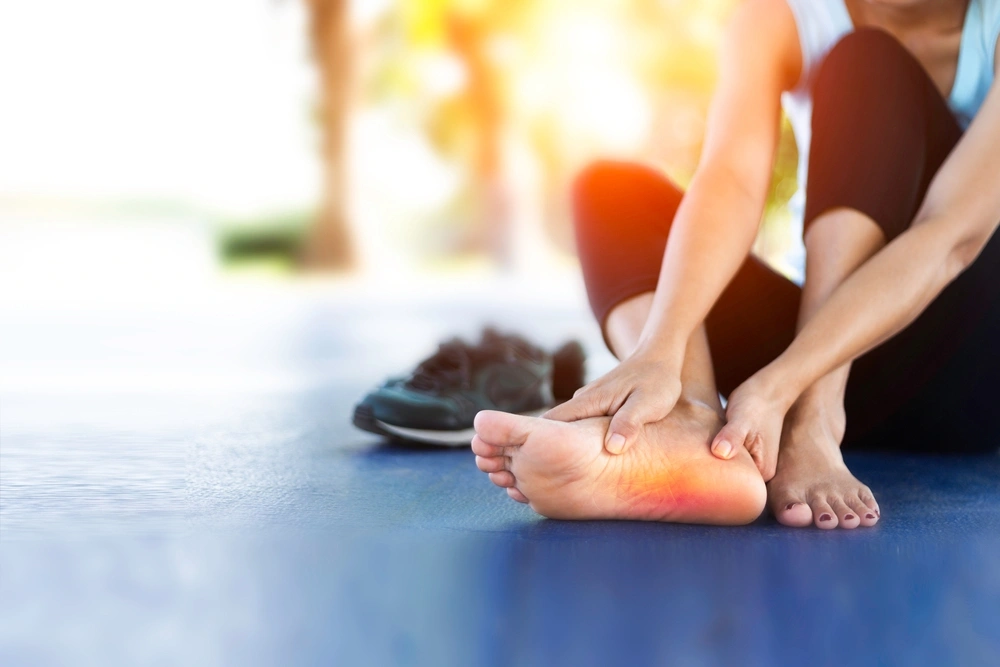Plantar fasciopathy (also known as plantar heel pain or plantar fasciitis) is an overuse condition of the plantar fascia at its attachment to the calcaneus. The plantar fascia consists of type 1 collagen and has common tendinopathy traits, hence we recommend using the term ‘fasciopathy’ rather than the former ‘plantar fasciitis’ since the suffix “-itis” normally refers in medicine to an inflammatory process which is not always present in this condition. Plantar fasciopathy is the most common cause of plantar heel pain, which has an estimated prevalence of 4-7%. It commonly affects very physically active people (e.g. runners) or people with high amounts of standing occupational work (who may also have a high BMI).
What is the presentation of the symptoms?
The pain related to plantar fasciopathy is usually of gradual onset and felt classically on the inferior medial aspect of the heel. Initially, it is worse in the morning when getting out of bed (referred to as ‘first-step pain’) and decreases with activity, only to return with an ache post-activity.
Periods of inactivity during the day are generally followed by an increase in pain as activity is recommenced. As the condition becomes more severe, the pain may be present when standing and worsen with activity. Some people may also experience atypical pain when non weight- bearing, for example, when they go to bed at night. Examination reveals pain or tenderness along the medial tuberosity of the calcaneus, and this may extend some centimeters along the medial and central components of the plantar fascia. Stretching the plantar fascia via dorsiflexion of the hallux, such as during the windlass test, may reproduce pain and may assist with palpation of the plantar
What is the best treatment?
Recently has been released a systematic review of the literature trying to answer this question. “Management of plantar heel pain” published by Dylan Morrissey Et. At. Came out with The Best Practice Guideline (BPG). Their conclusion was that due to the lack of high quality studies, the only certain approach was based on limited amount of articles and has been divided in 3 level of approaches:
1) The Core approach for 4-6 weeks
Education: Intended as individualized approach based on the person, knowing that plantar fasciopathy can appear either to sedentary or active people, education is meant to explain how to approach the load, therefore to increase it with sedentary people or reduce it with active people. Partial attention was given to the footwear, advising to prefer shoes with a higher rear foot support.
Stretching: performed with a towel rolled under the big toe and performing a classic calf stretching. Holding it for 30 seconds and repeated multiple times a day
Taping: intended to support the fascia and the medial arch of the foot, should be done with rigid tape
2) Shockwave Therapy: If the first approach fails after 4-6 weeks, than probably shockwave can help to reduce the pain and increase functionality. However a gradual re-loading exercise program must follow this method.
3) Orthoses: custom made insoles have shown to be beneficial with a moderate level of evidence.
More studies on Plantar Fasciopathy
That’s it?? Nothing more?
As I said before, this is based on a very rigid selection of studies. However there are many more studies done with different type of approaches, let’s go through them:
1) Strengthening exercises: Moderate evidence. It is important to re-introduce stress around the fascia gradually but progressively. Here is the importance of individualization.
2) Cortisone injection: Moderate evidence. It may be considered for a short term relief (4 weeks), however injecting liquid inside the fascia comes with risk like fascia rupture, fat pad atrophy and plantar nerve injury. Needs to be discussed with the patient before choosing this option.
3) Dry needling: Low level of evidence. Some trials have shown improvements in short term, however the quality of the study is low.
4) Massage: Low evidence. The plantar fascia is a very strong piece of tissue. There is no possible way of stretching it manually. However some people might appreciate some manual release.
5) Silicone heel pads: Unclear evidence. It is ideally beneficial but we have no proofs to support that
6) Self-massage with frozen bottle or trigger ball: No evidence. although commonly used there is no proof of benefit
7) Non-steroidal anti-inflammatory drugs: No evidence. Perhaps the idea of reducing inflammation make sense only in acute phase (within 1 week of onset) later the source of pain is not directly due to the inflammation, that’s why there is no evidence
8) Surgery: Unclear and low quality. Surgical option include plantar fasciotomy +- nerve release, but the level of knowledge on the outcomes is quite low therefore is not advisable considering the risks.
